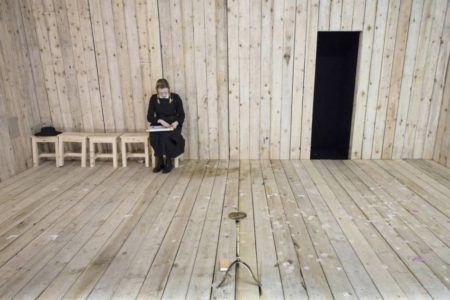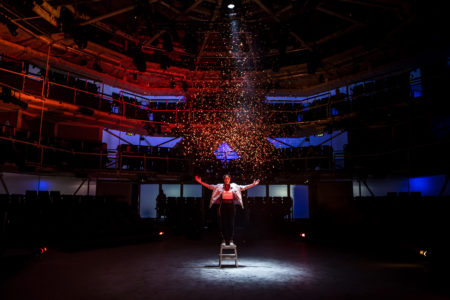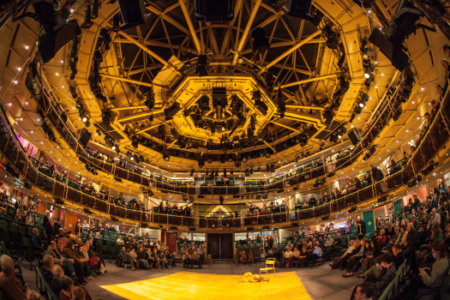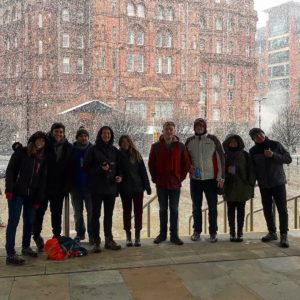REPOST: Taking Up Space: Playwrights, Audiences and Everything In Between- Bridget Minamore
For many of us, theatre—writing it, writing about it, working with it, working in it—is less of a hobby, less of a job, and more…
Theatre, says writer, performer and director Tim Crouch, is “a rare location for collective thinking”. Director Ellen McDougall expresses something similar: “theatre is one of few places where we collectively agree to sit amongst people we don’t know and share an emotional experience with performers who are present in the space with us.” In an era of sprawling digital networks, it’s one of the few physical – rather than virtual – places where we still gather with strangers. We share the same space and together we experience something. “It’s a cliché,” says Bruntwood Prize shortlisted playwright Joshua Val Martin, “but theatre has accidentally become the most radical art form.”
When writing a play, it’s easy to focus on the page. But scripts are one of the crucial building blocks of a live encounter with an audience. Unlike film or television, theatre’s audience exists with it in the same room – a fact that poses both challenges and opportunities for the playwright. As writer, performer and Royal Exchange associate artist Chris Thorpe puts it, theatre “allows you to ask things of people that other media can’t ask”. How far, then, should the audience factor into the playwright’s thinking?

Royal Exchange Theatre Associate Artist Chris Thorpe
Approaches differ from writer to writer. At one end of the spectrum, theatre-makers like Crouch build their scripts around the live presence of spectators. “They guide my hand, the audience,” he says. He describes his work as deliberately unfinished, explaining that “the ultimate goal is for the audiences to finish the work”. In the second half of Crouch’s play ENGLAND, for example, the audience collectively represent a character in the drama, while The Author removes the stage entirely, making the audience itself the setting for the play. “I write work that will encourage a more active role for an audience,” Crouch explains. “Without them there is something missing.”
For many writers, the circumstances dictate if and how the audience fits into their thinking. “If it is a commission, for a specific place or a specific audience, then yes I always have them and the space in my mind,” says poet, performer and playwright Sabrina Mahfouz. “If it is a play I’m writing because I have to, one of those ones that nobody has commissioned but it won’t go away and I have to get it down – the best kind, of course – then I hardly think about the audience.” Val Martin agrees, saying “the only time I’ve not [thought about the audience] is when I’ve had a proper impulse to write”.

Poet and playwright Sabrina Mahfouz performs during the closing event of the 2014 Palestine Festival of Literature. Photo credit Rob Stothard/Getty
When writing This Is Not America, which received a Commendation from the Bruntwood Prize judges in 2017, Val Martin had a very specific audience in mind. “I wrote for the audience I knew,” he says, remembering the amateur dramatic shows that he grew up watching in Bolton’s Methodist churches. “Those thrillers and farces were my theatrical education. Those plays in Bolton were events. Important events at the heart of a community and an integral part of social calendars. The build-up and aftermath were part of it – and the talking during too. Writing This Is Not America, in the back of my mind I was thinking ‘well, that audience takes a good ten minutes to concentrate, and they’ll start tutting if the first half goes on too long’.” He adds: “I use them as my compass because they ask the fundamentals of what makes a good event.”
According to Mahfouz, “theatre is all-consuming” – at least most of the time. Once sat in a theatre auditorium, the audience’s sole focus is on what is happening in front of them. It’s one of the few places where we aren’t flitting between different tabs and devices, and so it’s a place where writers can demand more of audiences than they might do on screen. “It becomes perfect for intense depictions of relationships,” says Mahfouz. “You need every word to reach the listener and you need that word to be infused with the complexity of meaning a voice can bring to it.”
Sometimes, though, it can be helpful for playwrights to ignore the audience. Val Martin, for example, pushes them to the back of his mind when writing a first draft. “Because the first draft is invariably shit, and the only way I finish is pretending it isn’t,” he explains. “Then when I’m finished I try to work out the why, where and who.” E V Crowe, the writer of plays including Hero and The Sewing Group, agrees that the second draft is the best time to bring the audience into the equation. “There are practical questions like is this too much information all at once? And then cultural questions, as in is x common knowledge or does it need to be set up or explained more? And then maybe later in preview it becomes obvious something the audience need to know for the story is being undermined somehow, and so because I want them to follow the story the way I intended I’ll try and fix it.”

The Sewing Group- photo credit Elliot Franks Photography
But there’s equally a danger of second-guessing the audience’s reactions. “There are ways in which it’s tremendously helpful to think about the audience, and there are ways in which it isn’t,” suggests Thorpe. “It’s not helpful, I think, to think about what they will think of the play, or of the piece. It’s not something you can predict or control, and often it can lead to a kind of self-censorship.” He warns against treating the audience as a “monolithic block of opinion”; an audience is, after all, just a collection of individuals with different experiences and opinions. Crowe echoes this warning: “as an audience member I am uncomfortable when I feel the writer has made too many assumptions about who I am and what I might think, and the act of watching the play turns me into that person”. Thorpe advises, instead, that playwrights should be thinking about “how you can use that liveness in the room to make the subject matter or the thinking of the piece a live experience for the audience”.
Ultimately, the decision of how and when to start thinking about the audience is down to each individual writer. “I think playwrights should follow their own instincts when it comes to starting work on a play,” says director Jude Christian, who worked with James Fritz to stage his Bruntwood Prize-winning play Parliament Square. “Write about what excites or fascinates or infuriates you, write stories that you want to invent, flesh out and bring to life,” she advises. “Everyone’s got a different way in to writing, and some people might find it inspiring to think about an audience at the very beginning, whereas others might need to live inside their own heads for a bit.”

Parliament Square- photo credit the Other Richard
One of the characteristics that makes drama distinct, though, is that it doesn’t just live inside the heads of writers and readers. We sometimes think of plays as literature, but they are written to breathe the same air as an audience, in a real place and time. “I struggle to believe plays have abstract value not given by place and people,” says Val Martin, questioning the significance often given to plays on the page. We can’t think of plays in the same way we think of novels or poems, because they rely on a live encounter between bodies in space.
“I often wonder where the play is at the end of the night,” says Crowe, similarly suggesting that the entity we call “the play” is something intangible that exists somewhere between page, stage and audience. “Will the play start and end literally on the stage, will it be in the space in between the stage and the seats? Will it be purely in each audience member’s mind? Where is the play? Some makers talk about this at the beginning of the process too. That the play is not the play. That the play you have in front of you on the page is not the play.”
Because plays will – if performed – exist in a specific time and space, it makes sense to consider that space. The Royal Exchange, with its unique clash of architectures and in-the-round auditorium, is a fascinating example. Val Martin tells me that a few years ago he entered the Bruntwood Prize with a play that had the Royal Exchange in mind. While the script didn’t win, he found those parameters a useful writing exercise. “When it’s in-the-round particularly, space and audience go hand in hand,” he notes. You can’t ignore the presence of other audience members when they are looking back at you from the opposite side of the stage. “I love theatre spaces in-the-round like the Royal Exchange,” says Christian, “where watching the rest of the audience is as much a visual and active component of the production as the play itself.” That won’t be the case in every space, and often writers don’t know where a play might end up being staged, but visualising an auditorium – whether in-the-round, proscenium arch or black box – can help playwrights to think of a play as something that lives and breathes.

Royal Exchange Theatre main stage. Photo credit Joel Fildes
What about when – if you’re lucky – the script gets handed over to a director? Often, it’s during rehearsals that a play’s intended relationship with its audience is imagined and refined, preparing for the moment when it first meets spectators. Christian believes that at this stage scripts need to be handled delicately. “It’s important to take care of a playwright’s work – because, more often than not, it’s their heart, soul, self-esteem, or something else equally precious and vulnerable – and to remember that they know their own play far better than you do when you first encounter it, but what you’re developing and rehearsing is that first encounter with the play for an audience.”
Some writers will have spent more time envisaging that encounter with an audience than others. As a director, McDougall is interested both in plays that demand interpretation and scripts from writers who have already given careful thought to staging. “I enjoy working on scripts that are a provocation to a director to imagine as a live event,” she says, referring to plays that give very little indication of how they might be staged – sometimes to the extent of not assigning dialogue to specific characters, as in Martin Crimp’s Attempts on Her Life or Simon Stephens’ Pornography. “Equally,” she adds, “it is always really pleasing to read something where the idea of play and the live moment has been woven into the text.”
Thanks to its unpredictability, it can be difficult for playwrights to consider the live moment when writing scripts. Thorpe boils it down to one central question for writers to ask of their plays: “What are the means by which this is altering reality in the room that it’s in? Or playing with reality, or speaking to people. It’s about the mechanics of the moments of the piece; being really clear about when it’s reaching out to the audience, how it’s reaching out to the audience, and what it’s asking them to do beyond the default of just sitting there and listening to it and watching it.”
Val Martin, meanwhile, has learned as much about liveness from his side job running walking tours around Manchester as he has from theatre. “The tours use pretty much exactly the same script that I wrote when I first started them four years ago,” he says. “Yet the tour’s quality varies so extremely depending on who is there.” While a guided tour might involve more direct audience interaction than much theatre does, the same principle of the content being received differently by different audiences applies in the auditorium. The experience has taught Val Martin that “the more you know an audience, the more that’s achievable”.

Joshua Val Martin and walking tour
For Crouch, the volatility of live performance and the variation in audience reaction from night to night is part of the thrill of writing for theatre. His plays are written in a way that amplifies this liveness, rather than attempting to mitigate the unpredictability that comes hand in hand with theatre as a medium. “The plays can’t be replicated, can’t be mechanically reproduced each night in the same way,” he says. “If it’s genuinely live then the work you present in front of an audience should be different every time.” Most strikingly, Crouch’s two-hander An Oak Tree is written for a different, unrehearsed second actor in each performance. It is, by design, vastly different each night.
The writer, then, has decisions to make about how to use the liveness that is part of the fabric of theatre. “I think in theatre we are always aware of each other,” says McDougall. “We always know it’s an actor. That’s an opportunity sometimes. It is also something we can actively be asked to forget – to suspend our disbelief and totally imagine the scenario being played out as if it was real. In the latter case I do think there’s then a question of how the evening is handed back to the audience. Is it a moment of escapism before returning to their lives, or is there a way to stitch the questions and ideas together so that we somehow leave the theatre changed?”
Thorpe similarly stresses the choices that are available to writers working in a live medium. “As a writer it gives you a whole load of formal choices that people still don’t take that often in writing for theatre,” he says, “about how you’re going to involve the audience in the investigation of that question – how you’re going to take advantage of the fact that you’re all breathing the same air, that you’re able to look into each other’s eyes, that you can ask them to give you something of themselves in a way that will, on any given night, profoundly affect the outcome of that investigation.” He adds that a play doesn’t have to exploit its liveness, but that writers should be aware of all the options available to them beyond the conventional naturalistic drama. “It’s about knowing that you have more choices than you think you have as a writer.”
And then, when the play finally reaches the stage, there’s the tricky question of how far the playwright is responsible for the audience and their reactions. As Christian warns, it’s not possible for a writer to fully control an audience’s response. “You definitely can’t wish it out of existence,” she says, “so if you’ve got a hunch that certain moments will very likely elicit a particular response and you emphatically don’t want that response at that point, then change or cut what you’re doing, because it’s not an audience’s responsibility to watch your play the way you want it watched, moment by moment.” One of the joys of theatre as a live, collective experience is encountering difference; not everyone in the audience will think and react in the same way as the playwright.
When rehearsing Parliament Square, it was important for Christian and Fritz to consider the many different – and in some cases extreme – ways in which audiences might respond to the play. Christian remembers that they talked about “taking responsibility for how some people might interpret the play, because it deals with subjects like violent political protest and suicide”. There are ongoing, knotty conversations among theatre-makers about how to care for the audience without sacrificing artistic integrity or aesthetic impact. It was something that Thorpe also thought about at length while making Confirmation, a play that voiced the views of a white supremacist.
While Thorpe firmly believes that writers shouldn’t self-censor, he also questions shocking the audience for the sake of it. “I think the writer has to have a really clear idea – whatever kind of material they’re using – of what the piece is for and who it is for,” he says. “And I think then there’s a really necessary conversation in the production of something – of which the writer absolutely has a responsibility to be a part – about how the piece is presented to the audience to give them the information and the physical opportunity to take responsibility for themselves, in terms of their reaction to the piece. So it’s not about second guessing individual reactions, but it’s about being clear about the content of the piece in a way that hopefully doesn’t compromise the artistry of the piece, and about staging the piece in a way which gives people the opportunity to make the decision not to come, or to make the decision to leave if they’re there.”
Thorpe adds that “the main question that comes into play in terms of your responsibility to the audience is ‘am I wasting their time or not?’”. He advises that, at some point in the process, all writers need to ask themselves “why am I doing this?”, to which there are countless possible answers. “If ‘why am I doing this?’ comes up with the answer ‘I don’t know’, that is fine,” he continues. “But ideally it won’t be ‘I don’t know’ forever; at some point in the writing process it will switch over to ‘oh, that’s why I’m doing this’ and you’ll know.”
It’s easy to overestimate the collective qualities of theatre or to have hubristic aims to change audience members’ lives in the space of a performance. But the beauty of the art form is that, regardless of the play’s goals or their success, audience members will leave the auditorium altered – even if only in the most miniscule of ways. “I try to value the millions of connections and associations being made in the brain,” says Crowe. “When people leave the theatre they have hopefully imagined which is a biological act, generating new connective tissue. Potentially, people leave literally physically changed.”
Comments
Add comment